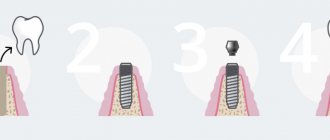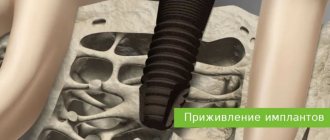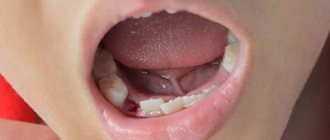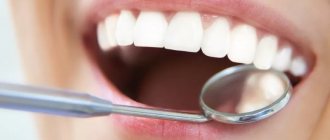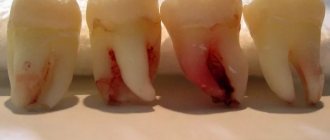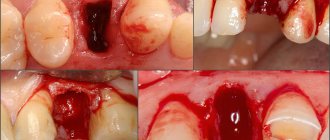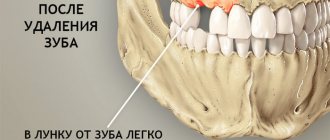Removal or extraction of a diseased tooth is a surgical procedure, after which it is necessary to carefully monitor the condition of the gums at the site of intervention. After the procedure has been carried out, it is necessary to place a special turunda into the resulting cavity. To carry out this rather complex procedure, the surgeon’s professionalism alone is not enough, because the postoperative period is quite dangerous if proper care of the affected gum is not carried out at this time. In this case, if the treatment is insufficient, some kind of infection may get into the hole and cause complications.
To avoid any problems with healing, the doctor puts a special medicine in the socket of the extracted tooth. With its help, the wound is protected from infections and external influences. What medicine is put into the hole after tooth extraction? Let's talk about this in the article.
How is the affected tooth removed?
The procedure itself should only be performed by an experienced surgeon and only when other treatment methods can no longer help. There are a number of reasons that can trigger the removal of an affected tooth:
- if the crown of the tooth is completely destroyed;
- when the patient is indicated for prosthetics;
- if complications arise during the eruption of a wisdom tooth;
- if filling requires perforation of the root canal.
Important ! There are cases when there is every reason to remove a tooth, but the patient has contraindications to this. In such cases, most often the intervention is carried out within the walls of a hospital with subsequent monitoring of the patient’s condition.
There are a number of main contraindications to surgical tooth extraction. These include:
- previous heart attacks;
- high blood pressure;
- arrhythmia;
- blood diseases;
- mental problems or neurological diseases.
If no contraindications have been identified in a patient who needs surgical removal of the affected tooth, then he is referred to the procedure itself, which should be carried out according to the following scheme.
| Stage | Description |
| Visit doctor | Before performing the procedure, the doctor must find out whether the patient has allergic reactions to any anesthetics, cardiovascular pathologies, or whether the patient suffers from hypertension. |
| Anesthesia | After all the necessary information has been obtained, the patient is sent for anesthesia. A fairly large number of different means are currently used to remove teeth. Their duration of action is from forty minutes to three hours. |
| Preparation | Next comes preparation for the intervention itself: in order not to injure the gum during manipulation, it first peels off from the tooth bone by at least five millimeters. This procedure is carried out using a special tool. The surgeon places special forceps on the tooth, and then begins to swing the tooth itself with them in order to destroy the ligaments attached to the jaw bone. |
| Removal | The affected tooth itself is pulled out, that is, extraction. After the affected tooth has been removed, the resulting hole must be thoroughly examined. This is necessary so as not to leave tooth fragments or a cyst in the wound cavity. If the extraction of the affected tooth took place in the presence of flux, then after its removal the gums are cut in the right place and the pus is released. After this manipulation, a drainage is inserted into the wound cavity. |
| Treatment | After the procedure is completed, you need to treat the wound itself. If pus is found at the site of the lesion, then in this case the hole must be washed with an antiseptic solution, and then an anti-inflammatory agent should be placed in the wound. If the hole itself is too large after extracting the tooth, then a suture is necessary. |
| Consultation | After the procedure has been completely completed, before discharge, the doctor must instruct the patient in detail on how to care for the hole during the healing period, and also prescribe any medications if necessary. |
After the tooth is removed and before the patient goes home, the doctor inserts a special medicine into the tooth socket. It is necessary to protect the wound from various influences, as well as for faster and more proper healing. Some patients complain that the turunda with the medicine interferes greatly, but this will have to be endured.
Important ! If you remove the turunda ahead of time, serious complications may develop, which will have to be dealt with not only by the dentist, but also by other doctors.
The doctor prescribes exactly the medicine that is safe for every person. True, it does not have the most pleasant taste, but a person will have to ignore this factor if he wants the wound to heal as quickly as possible.
There are exceptional cases when it is simply impossible to remove the affected tooth according to the scheme above. The reason for this may be the following factors:
- if the tooth root is crooked;
- if the bone tissue of the tooth is too fragile;
- if the crown of the affected tooth is already completely destroyed;
- if the figure eight is in a position of incomplete eruption or in a horizontal position.
If a patient who needs tooth extraction has any of these characteristics, then the intervention is performed in a different way. First, the gum is cut and peeled away from the bone. After this, the specialist drills out the desired area using a drill, which creates access to the root of the required tooth.
Important ! In some cases, the partitions between the roots of the tooth are sawed, after which each root is removed one by one.
After such procedures, healing is more difficult and longer. Such an intervention may cause the patient to develop stomatitis. In many cases of such intervention, a secondary infection is attached to the affected area.
However, no matter which tooth is removed, medicine must be placed in the hole. This procedure is required.
What to drink after tooth extraction: taking medications
The doctor decides what medications to take after tooth extraction. The list of recommended medications includes:
- antihistamines – reduce swelling and improve overall well-being;
- painkillers - analgesics are taken if necessary every 4-6 hours after the end of anesthesia;
- antibiotics - you can take them only as prescribed by a doctor after a complex removal, if inflammation of the socket develops, or if there are concomitant diagnoses.
Aspirin is strictly prohibited, as it thins the blood and can increase bleeding.
What should the patient do after the procedure?
After the procedure has been completed, the specialist must carefully explain to the patient his next steps, as well as the rules for caring for the wound during the healing period.
- The turunda or cotton wool that was left by the surgeon in the hole does not need to be removed by yourself. If the tampon placed by the doctor falls out ahead of schedule, the patient must return to the specialist to install a new turunda. If this is not done, an infection may enter the wound cavity.
- If after the procedure the cheek is very swollen, you can apply ice or a cold compress to it. After this procedure, it is forbidden to heat the affected area and apply hot compresses.
- You can eat food after tooth extraction only two hours after the procedure. It is recommended to eat only liquid and light foods that do not contain solid pieces.
- A blood clot forms in the hole where the tooth was pulled out. It is prohibited to remove it or touch it. The first time after the procedure, you must brush your teeth with caution and do not use any rinses.
- For 7 days after tooth extraction, it is prohibited to carry out other interventions in the oral cavity.
- During the healing period, it is not recommended to overheat, for example, take a steam bath, and also exercise with caution. It is also strongly recommended to stop drinking alcoholic beverages and smoking cigarettes for two days after the procedure.
- After tooth extraction, pain often occurs at the extraction site. In this case, quite often not only the hole, but the whole head as a whole can hurt. Also, the patient may experience pain while eating, regardless of which side of the teeth he chews on. Experts recommend coping with these problems with the help of painkillers, such as Pentalgin or Tempalgin. In this case, it is advisable to take the drug in combination with Suprastin.
Despite the fact that there is medicine in the hole, a person may still feel pain and some burning. Such unpleasant sensations will have to be ignored.
Important ! If the sensations intensify, it is recommended to consult a doctor again so that he can examine the wound and, if necessary, take action.
In the first 24 hours after removal
What to do after tooth extraction during the first 24 hours:
- The gauze pad should be removed from the mouth after 20–30 minutes. In some cases (for example, in patients with arterial hypertension or simply poor blood clotting), it is better to hold it longer - 40-60 minutes. Its purpose is not to absorb blood, but to compress the socket to stop capillary bleeding.
- Do not eat or drink for 2–3 hours. Until a more or less dense clot has formed in the hole, food debris can get into it and cause complications.
- For 3 days, exclude rough, hot, spicy foods from the diet. Rough food, especially products such as crackers, chips, nuts, can get into the socket and cause inflammation. Hot or spicy foods increase the amount of blood flow in the surgical area, which can lead to increased postoperative inflammation and the appearance of pain, swelling, etc. Optimal nutrition after surgery is food that does not irritate or injure the oral mucosa.
- For 3 days, avoid baths, hot tubs, saunas, and solariums. Avoid physical activity and any heating of the body. You can take a shower and wash your hair. But not for long and not with hot water. Under no circumstances should you apply heat to the surgical area. Due to heating, blood flow in the area of the extracted tooth increases, and this can lead to serious complications.
- Do not pick at the hole or try to clean or rinse it. Try not to touch the tooth socket with your tongue. Even if you notice “something abnormal” in the socket of an extracted tooth, it is best to consult a doctor. Trying to clean it yourself usually leads to infection of the socket.
- You cannot rinse the socket area on the first day, use lotions, baths, ointments, compresses, etc., unless your doctor recommends it. Rinsing and bathing on the day of surgery often dissolves and washes away the blood clot.
- Careful oral hygiene. Teeth must be brushed regularly, 2 times a day in those places that are not adjacent to the socket of the extracted tooth. To clean, use a minimal amount of toothpaste (you can use no toothpaste at all) to make it easier to wash off. After tooth extraction, you cannot use an irrigator.
- The use of cold is for the most part justified. A cold compress not only constricts blood vessels and reduces the risk of swelling, but also reduces blood flow in the surgical area and prevents postoperative inflammation from developing. It is best to consult your doctor about the use of cold compresses.
- Patients suffering from diseases of the cardiovascular system must monitor their blood pressure and take appropriate medications. In 90% of cases, the cause of alveolar bleeding, swelling or hematoma is an increase in blood pressure. Therefore, stable blood pressure is a necessary condition for a comfortable postoperative period.
- If your doctor prescribes medications for you, you must take them according to the regimen suggested by the doctor.
- If something bothers you, or you have additional questions about your well-being, first of all contact your doctor.
It is important to understand that the body perceives tooth extraction as an injury and gives an appropriate reaction to it - post-traumatic inflammation. Its nature largely depends on both the volume of intervention and the condition of your body. The purpose of the recommendations and prescriptions that the doctor gives you is precisely the elimination of this inflammation. Therefore, how the postoperative period will proceed, how comfortable and calm it will be, largely depends on you.
About the medicine
The medicine that is placed in the hole can be applied to a piece of gauze, which is subsequently inserted into the hole. In this case, after a certain amount of time indicated by the doctor, it needs to be taken out. This can be done either independently or during your next visit to the dentist. If this is not done in time, the process of putrefaction may begin, which will greatly complicate the situation. It is also not recommended to take out the gauze ahead of time, since food particles can get into the hole and the tongue can touch it, which will interrupt the healing process and also cause complications.
There is another way to install the medicine - in a hemostatic sponge. It already contains a medicine that helps disinfect the socket cavity and helps stop bleeding. You cannot take this sponge out - it will dissolve on its own. Most often this happens within 1-2 days, but in some cases the sponge may remain in the hole for 5-6 days. There is no need to be afraid of this. As a last resort, you can consult a doctor who will examine the wound and determine whether healing is proceeding normally.
Often the medicine in the sponge is very bitter, and this causes severe discomfort to the person. Unfortunately, nothing can be done about this, since getting rid of the sponge ahead of time is strictly contraindicated. To eliminate bitterness, you can drink sweet tea or juice.
Remember ! No circumstances can influence the ability to remove the medicine from the hole ahead of time. After 3-4 days, the surface of the hole will heal, and you will no longer have to experience discomfort.
People often wonder what kind of medicine is used for these purposes. Sometimes the gauze that is placed in the hole is treated with iodine - this will both disinfect the wound and prevent bleeding. The hemostatic sponge is already treated with a special substance consisting of boric acid, collagen and nitrofural, which helps stop the bleeding and protect the hole from various influences. But most often dentists use Alvozhil.
No other means are used for inserting into the hole.
How long does it take for a hole to heal?
The wound left after tooth extraction has a certain healing pattern.
- After the tooth extraction procedure is completed, the circular ligament located around the crown of the extracted tooth begins to contract.
- A short amount of time after the procedure, you may notice an accumulation of blood in the hole. The resulting clot helps protect the wound from infection or small food particles. Over time, the hole begins to become overgrown with fibrous tissue.
- After a certain amount of time, which depends on the characteristics of the human body, as well as on the correct care of the hole after the procedure, the surface of the wound heals and the affected area of the gum is restored.
- After this, over time, new epithelium grows on the surface of the gum, as well as the development of bone tissue at the site of tooth extraction.
Important ! The normal healing of the hole is facilitated by the medicine that is placed in the hole. Without it, the wound will not heal.
Many patients worry about the healing of the wound that remains after tooth extraction. The doctor must explain to the patient that the wound can heal completely only after two or three weeks, provided that all care rules are followed. If they were nevertheless broken or an infection was still able to penetrate the wound, then with repeated disinfection, complete restoration of the affected area will occur in five months.
What is allowed during the healing period?
- Non-solid semi-liquid food.
- Gentle oral hygiene.
What is prohibited during the healing period?
- Drinking alcohol and smoking cigarettes.
- Drinking liquids with a plastic straw.
- Harsh brushing of teeth in general and especially in the healing area.
- Eating dry and solid food.
- Sudden movements of the cheekbones for one week after the procedure.
Routine and nutrition after tooth extraction
The diet after tooth extraction is followed for about a week while tissue restoration occurs. The most serious restrictions apply to the first hours; later the requirements become less stringent.
After tooth extraction, you can eat 2-3 hours later, drink immediately after removing the gauze swab. Recommendations for what to eat after tooth extraction:
- Soft products to prevent mechanical damage to the socket. The first day after tooth extraction, liquid food is indicated, then minced meat dishes, purees, and soups are also allowed.
- Warm dishes at a comfortable temperature. Excessively hot or cold foods may cause recurrent bleeding.
Also good prevention after tooth extraction is chewing food on the side opposite to the removed unit, which preserves the protective blood clot intact.
Auxiliary medications for tooth extraction
If, after the tooth is removed, any complications begin at the intervention site, then modern pharmaceuticals can cope with them. With the help of various medications, the patient can not only eliminate the resulting secondary complications, but also strengthen his immunity as a whole. Quite often, specialists, to ensure against possible complications, in particular, various inflammations and suppurations, prescribe antibacterial drugs in the postoperative period. At the same time, the patient also needs to strengthen the immune system, which will help the wound heal faster. To do this, doctors prescribe vitamin complexes to the patient. Thus, in addition to the medicine placed in the hole and affecting its healing, the patient is recommended to take other drugs to speed up the process.
If during the procedure the patient was identified with any peculiarities or complications and tooth extraction was not without additional trauma, then a number of medications are prescribed in the postoperative period, since in this case there are additional risks of complications. The main thing is that the patient treats the postoperative period responsibly and does not neglect the doctor’s advice and the medications prescribed to him.
Important ! According to statistics, every third patient who has had a tooth removed needs to take antibiotics.
Taking antibiotics after the procedure
Dentists quite often resort to antibiotics in the postoperative period, especially after tooth extraction. But not every patient who has undergone tooth extraction requires antibiotics. They are prescribed only in the following cases:
- if the patient experiences inflammatory processes in the gum area;
- if the patient is elderly;
- if complications arise during the operation or features of the anatomy of the teeth are revealed, which contributes to more extensive trauma;
- if the patient has a reduced immune system or suffers from any blood diseases.
This list is not all of the reasons for prescribing antibiotics in the postoperative period, because each individual case has its own characteristics. An experienced dentist will be able to easily determine which patient needs to take medications after tooth extraction. The doctor must determine the duration of administration and dose individually for each case. Most often, the course of taking the drug after tooth extraction lasts from five to seven days. In rare complicated cases, treatment can last up to fifteen days. It is simply impossible to determine the average dose of antibiotics that is needed, since each individual drug has its own individual characteristics.
Important ! It is strongly recommended not to take antibiotics unless prescribed by a doctor.
In addition to antibiotics, your doctor may also prescribe medications to normalize the microflora after taking antibiotics. The most commonly prescribed drug is Linex, but sometimes other drugs from the group of probiotics are also prescribed.
Stages of socket healing after tooth extraction
How to behave after tooth extraction is determined by the characteristics of the restoration processes. Doctors distinguish several stages:
- The first day after tooth extraction surgery. The extraction process is accompanied by tissue damage and rupture of blood vessels, which leads to bleeding. When the socket fills with blood, a thrombus or blood clot forms. It is very important to keep the blood clot intact, as it protects the wound from bacterial microflora and serves as the basis for the formation of new tissue.
- 2-3 days after removal of a chewing tooth. The patient's behavior is aimed at preserving the blood clot and protecting the socket from external injury. At this stage, the formation of connective tissue begins, which is responsible for gum healing.
- A week after tooth extraction. Recovery moves to a new stage - the clot turns white, swelling and pain disappear.
- 10-15 days after an appointment with a dental surgeon. The gums heal, and new bone tissue is actively formed in the cavity of the socket. A routine examination after molar tooth extraction is necessary to monitor the patient’s condition and remove sutures if the hole was sutured.
- The ordering of fibers and further compaction of bone tissue begins in the 3rd month after tooth extraction.
- Due to lack of load, atrophy of the upper part of the bone occurs, which previously served as support for the crown part of the tooth.
What to do next after a chewing tooth has been pulled out depends on the stage of healing of the hole and the dentist’s recommendations.
What painkillers can be taken in the postoperative period?
Most often, when local anesthesia wears off after a tooth extraction procedure, the patient feels pain in the area of intervention. The best way to eliminate pain is to take NSAIDs. This group of drugs is the most effective in eliminating toothache.
- The drugs "Nurofen" or "Ibuprofen" cope well with pain after surgery. It is necessary to take the drug 500-800 mg three to four times a day, depending on the intensity of the pain.
- "Ketorol" is one of the most effective and powerful drugs from the NSAID group, which can eliminate pain after the procedure in a fairly short time. It is also used two tablets three to four times throughout the day.
Basic rules of oral hygiene after tooth extraction
In order to prevent possible complications after the procedure, you need to strictly follow the rules of oral hygiene.
- Two to three days after tooth extraction, the mouth can be rinsed with a soda solution. It is diluted in the ratio of one teaspoon of soda to one glass of warm water. You can also rinse with other means that help faster healing, for example, Chlorhexidine. Rinsing should be done very carefully, as it can damage the integrity of the blood clot that has formed in the hole. Gentle rinsing is carried out by drawing a solution into the oral cavity. After this, you just need to hold the solution in your mouth for a while and then spit it out. This rinse will not harm the blood clot.
- Rinsing is necessary to prevent infection or food particles from entering the wound, which can cause suppuration.
There are a number of symptoms that indicate the presence of complications in the postoperative period. Among them:
- pain that does not subside for several days after the procedure. In the presence of such pain, even various painkillers cannot help;
- the patient notes continuous bleeding from the wound. In this case, the blood has a bright scarlet hue;
- The patient’s body temperature rises and remains for 24 hours after the tooth extraction procedure;
- slight swelling of the cheek after the procedure develops into severe swelling that spreads over the entire side of the face. The patient feels weak and drowsy;
- pus is leaking from the wound or the area around the wound has begun to darken. In this case, after a few days the patient experiences a persistent putrid odor from the mouth;
- the dentition may become mobile;
- divergence of applied sutures.
Important ! If the patient notices any of the listed symptoms, in this case it is necessary to urgently consult a doctor. If such complications are left unattended, they will soon develop into more serious pathologies that can threaten not only the patient’s health, but also his life.
Local complications arising after tooth extraction surgery.
Bleeding
Tooth extraction, like any other operation, may be accompanied by bleeding. After a few minutes, the blood in the hole coagulates and the bleeding stops. However, in some cases it does not stop on its own and continues for a long time (primary bleeding). Sometimes the bleeding stops within the usual time frame, but after some time it appears again (secondary bleeding). Prolonged bleeding is most often caused by local causes, less often by general ones.
Local reasons.
Bleeding can occur after tooth extraction when an acute inflammatory process has developed in the surrounding tissues, since the vessels in them are dilated and do not collapse. Late secondary bleeding from the socket occurs a few days after tooth extraction. It is caused by the development of the inflammatory process in the wound and purulent melting of the organizing blood clots in the vessels damaged during surgery.
Common reasons
. Prolonged bleeding after tooth extraction occurs in diseases characterized by impaired blood clotting or damage to the vascular system. These include hemorrhagic diathesis: hemophilia, thrombocytopenic purpura (Werlhof's disease), hemorrhagic vasculitis, hemorrhagic angiomatosis (Ren-du-Osler's disease), angiohemophilia (Von Willebrand's disease), C-vitaminosis; diseases accompanied by hemorrhagic symptoms (acute leukemia, infectious hepatitis, septic endocarditis, typhus and typhoid fever, scarlet fever, etc.).
The blood clotting process is disrupted in patients receiving indirect anticoagulants that suppress the function of prothrombin formation by the liver (neodicoumarin, phenylin, syncumar), as well as in case of an overdose of the direct anticoagulant - heparin. A tendency to bleeding is observed in patients suffering from hypertension.
Local methods to stop bleeding.
The blood clot is removed with tweezers and a surgical spoon, and the socket and surrounding areas of the alveolar process are dried with gauze swabs. After examining the wound, determine the cause of bleeding, its nature and location.
To stop bleeding from the hole, tamponade is performed using various means. The simplest and most accessible method is tight tamponade with iodoform turunda. After removing the blood clot, the hole is irrigated with a solution of hydrogen peroxide and dried with gauze swabs. Then they take an iodoform turunda 0.5-0.75 cm wide and begin to tamponate the hole from its bottom. Pressing and folding the turunda tightly, gradually fill the hole to the brim (Fig. 6.24). If bleeding occurs after the removal of a multi-rooted tooth, the hole of each root is tamponed separately.
To bring the edges of the wound closer together and hold the turunda in the hole, sutures are placed on top of it, retreating from the edge of the gum by 0.5-0.75 cm. Removing the gurunda prematurely may lead to re-bleeding.
In addition to iodoform turunda, the hole can be tamponed with absorbable biological hemostatic drugs (hemostatic sponge, fibrin film, hemostatic collagen sponge, gelatin sponge “Krovostan”, antiseptic sponge with gentamicin or kanamycin, hemostatic sponge with Ambien). In case of late secondary bleeding, the disintegrated blood clot is removed from the socket, irrigated with an antiseptic solution, dried and filled with some hemostatic drug. In these cases, it is preferable to use an antiseptic sponge with kanamycin or gentamicin, which has hemostatic and antimicrobial properties.
General methods to stop bleeding.
At the same time as stopping bleeding, agents that increase blood clotting are used using local methods. They are prescribed after determining the state of the coagulation and anti-coagulation systems of the blood (detailed coagulogram). In emergency cases, before obtaining a coagulogram, 10 ml of a 10% calcium chloride solution or 10 ml of a 10% calcium gluconag solution, or 10 ml of a 1% Ambien solution are administered intravenously. Simultaneously with these drugs, 2-4 ml of a 5% solution of ascorbic acid is administered intravenously.
Prevention of bleeding.
Before tooth extraction, it is necessary to find out whether the patient has had prolonged bleeding after accidental tissue damage and previous operations. If there is a tendency to bleeding, before surgery, a general blood test is performed, the number of platelets, blood clotting time and duration of bleeding are determined, and a detailed coagulogram is drawn up. If hemostasis parameters deviate from the physiological norm, measures are taken to increase the functional activity of the blood coagulation system, and the patient is consulted by a hematologist or therapist. For patients with blood disease, teeth are removed in a hospital setting. They are prepared for surgery together with a hematologist.
Socket postoperative pain
After tooth extraction and the cessation of the anesthetic, slight pain occurs in the wound, the severity of which depends on the nature of the injury. Painful sensations most often pass quickly. However, sometimes 1-3 days after the operation a sharp pain appears in the area of the socket of the extracted tooth. Patients do not sleep at night, take analgesics, but the pain does not stop. Such acute pain is most often a consequence of disruption of the normal healing process of the tooth socket and the development of inflammation in it - alveolitis.
Alveolitis
- inflammation of the walls of the socket - often develops after a traumatic operation that reduces the protective properties of tissues. The cause of alveolitis can be an infection in the socket when a tooth is removed due to acute and aggravated chronic periodontitis or complicated periodontitis. A predisposing factor is a decrease in the general immunological reactivity of the patient’s body in old age and under the influence of previous common diseases. Clinical picture. In the initial stage of alveolitis, an intermittent aching pain appears in the socket, which intensifies while eating. The general condition of the patient is not disturbed, body temperature is normal. The tooth socket is only partially filled with a loose, disintegrating blood clot. In some cases, there is no clot in it at all. The hole contains food debris, saliva, and its walls are exposed. The mucous membrane of the gum edge is red, touching it in this place is painful. With further development of the inflammatory process, the pain intensifies, becomes constant, and radiates to the ear, temple, and the corresponding half of the head. The patient's general condition worsens, malaise and low-grade body temperature appear. Eating is difficult due to pain. The tooth socket contains the remains of a disintegrated blood clot, its walls are covered with a gray coating with an unpleasant putrefactive odor. The mucous membrane around the hole is hyperemic, swollen, and painful on palpation. The submandibular lymph nodes are enlarged and painful. Sometimes there is slight swelling of the soft tissues of the face. In turn, alveolitis can cause a number of complications: periostitis and osteomyelitis of the jaw, abscess, phlegmon, lymphadenitis.
Treatment.
After local anesthesia or anesthetic blockade with lincomycin has been performed, the wound is treated. Using a syringe with a blunt needle, a stream of warm antiseptic solution (hydrogen peroxide, furatsilin, chlorhexidine, ethacridine lactate, potassium permanganate) is used to wash out particles of a disintegrated blood clot, food, and saliva from the tooth socket. Then, using a sharp surgical spoon, carefully (so as not to injure the walls of the socket and cause bleeding) the remains of the decomposed blood clot, granulation tissue, bone fragments, and teeth are removed from it. After this, the hole is again treated with an antiseptic solution, dried with a gauze swab, powdered with anesthetic powder and covered with a bandage. The bandage protects the socket from mechanical, chemical and biological irritants.
In the initial stage of alveolitis, after such treatment, pain in the socket does not recur. The inflammatory process stops after 2-3 days.
Sharp edges of the alveoli.
Socket pain can be caused by protruding sharp edges of the socket, which injure the mucous membrane located above them. Sharp edges of the alveoli most often form after the removal of several adjacent teeth or a single tooth (due to bone atrophy in adjacent areas). Pain appears 1-2 days after tooth extraction, when the edges of the gums above the socket begin to approach each other. Bone protrusions injure the gum mucosa located above them, irritating the nerve endings located in it. The pain intensifies during chewing and when touching the gums. This pain can be distinguished from the pain of alveolitis by the absence of inflammation in the socket area and the presence of an organizing blood clot in it. When you feel the hole with your finger, a protruding sharp edge of the bone is detected, and a sharp pain occurs.
To eliminate pain, an alveolectomy is performed, during which the sharp edges of the socket are removed (Fig. 6.25).
Prevention
There are a number of actions that the patient must take immediately after this procedure and which will allow him to prevent possible complications.
- After the extraction, the patient needs to tightly compress the dentition. This is necessary in order to press firmly on the tampon placed in the wound.
- The medicine should not be removed by yourself.
- The hole should not be touched with your tongue or fingers. This is necessary so as not to accidentally damage the blood clot that has formed in the wound.
- If the patient experiences unbearable pain, it can be relieved with the help of analgesics that were recommended by a specialist. The dosage should also be prescribed by the doctor, since each patient reacts individually to the tooth extraction procedure.
- During the period until the wound is completely healed, the patient should stop smoking. This process greatly interferes with the normal healing of the hole.
- If the patient detects symptoms of complications, then, without delay, he should consult a dentist.
The patient needs to be aware of symptoms that may indicate the occurrence of suppuration or any other complications. Having noticed any of the signs, the patient should immediately contact a specialist for advice and subsequent treatment. We must not forget that only proper maintenance of oral hygiene and compliance with all the necessary rules will help the wound heal much faster. You will find out the proportions of soda solution for rinsing teeth in the article.
The patient himself causes the “dry socket” effect to appear.
A dry socket will definitely manifest itself if the patient does not adhere to the dentist’s recommendations after tooth extraction and willfully allows such actions as
:
- thinking that he is making his condition easier by rinsing blood clots out of the tooth socket too often and intensively;
- thinking that his tongue has healing properties, he constantly “checks” with his tongue the surrounding tissue of the pit and the pit itself inside;
- Having convinced himself that he should drink in a thin stream, he drinks everything through a straw or sips all drinks from a spoon with his lips, thereby creating a vacuum effect in the mouth;
- not giving a damn about the doctor’s strict recommendations, he ignores the restrictions, and at least a little, at least a little, engages in heavy physical labor or sports during the rehabilitation period after removal (oh, like, look how cool I am!).
Dry socket syndrome in wisdom teeth
The concept of dry socket syndrome refers to the wisdom tooth. In the case of a wisdom tooth, this is practically alveolitis. It can also occur in this area, especially in the area of the lower wisdom teeth due to the fact that as a result of swallowing, as a result of opening the mouth, the muscles tense, which aggravate the occurrence of alveolitis.
What can dry socket syndrome lead to and what to do?
Dry socket syndrome can lead to very severe pain that radiates to the temple and ear. This is a very great torment: a person cannot, even if he is not sensitive, he cannot tolerate it, he will definitely take painkillers 4-5 or 6 tablets. And as a result of this, he will still go to the dentist. This dry socket condition will not go away on its own. It can only get worse - up to inflammation of the jaw, alveolitis. There can be very disastrous consequences.
